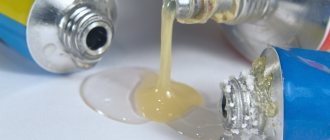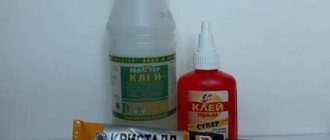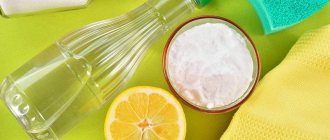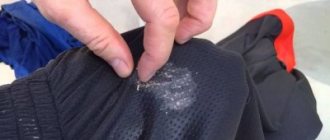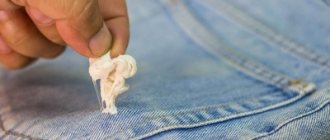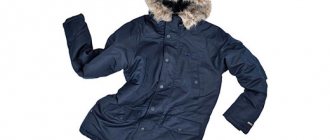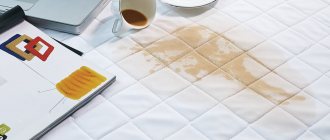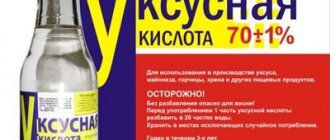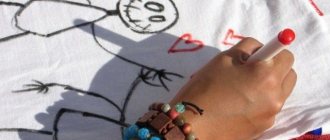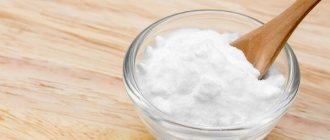Polyvinyl acetate glue or PVA glue is a synthetic glue and contains water in its base, however, in terms of adhesive strength it is no worse than its alcohol-containing analogues. If it gets on fabric, a stain of stationery PVA is easy to remove, but how to wash glue from clothing for construction or household purposes? Varieties such as Moment Joiner Super PVA, titanium or PVA Super glue are designed for more aggressive gluing, dry quickly and are quite moisture resistant. We will offer several options that will help remove even old traces of glue from clothing, while maintaining its appearance.
How to wash if the stain is fresh
How to remove PVA glue from clothes if a stain has just appeared? It is easier to deal with such pollution than with that which has had time to dry and be absorbed into the fibers of the fabric. To get started, do the following:
- Soak the liquid stain with a cotton pad or napkin. Apply the material carefully to prevent the mark from spreading. Do not smear or rub it in under any circumstances. Then you need to wash it in the usual way.
- Soak the item briefly in soapy water or dishwashing detergent. If necessary, thoroughly treat the dirt with a brush.
- There won't be any stains if you just dry your clothes thoroughly.
Act promptly: try to immediately remove the PVA glue stain from clothing as soon as it appears. This will save you from having to resort to chemicals and other methods that are not always safe for the fabric. For information about other types of glue, follow the links: super, moment.
Use of solvents
Construction adhesive differs from office PVA in its greater bonding strength and, accordingly, it is much more difficult to remove. If the previous tips did not help, then use heavy artillery - solvent. The following products are suitable: white spirit, turpentine, acetone, purified gasoline or store-bought solvent for paints, enamels, varnishes, etc.
Use the solvent with caution and only if previous methods have failed. Follow these steps:
- Pre-test the solvent's effect on the fabric. Touch the underside of the clothing in an inconspicuous place several times with a cotton swab soaked in solvent, wait a few minutes, if the fabric has not changed in color, then the product can be used.
- If the stain is large and dry, scrape it off with a knife or the rough side of a sponge soaked in baking soda.
- Apply a cotton pad with solvent to the fabric for a few minutes. This will help dissolve the PVA glue and make it pliable to water.
- Wash the area damaged by the glue with laundry soap or powder.
- Wash the entire garment.
Freezing
How to remove PVA glue from clothes if the stain has dried? As you know, it is made on a water basis, so it freezes when exposed to low temperatures. Follow the instructions to remove stains using one of the proven and reliable methods:
- Place the item in the freezer for a couple of hours.
- Then take it out and break off the frozen particles.
- The remaining PVA can be carefully scraped off with a knife, then wiped off with a brush.
- If there is a stain left, remove it with ammonia.
After this procedure, you can wash your clothes in a soapy solution. We will tell you how to remove tomato stains in another article.
Removing office glue
PVA office glue is a mixture of aqueous polyvinyl acetate emulsion and plasticizing additives. Office glue (used for gluing paper) is easy to clean because it has a lighter structure than construction glue. In many cases, just warm water is enough to completely remove it from the fabric. The fabric with the stain must be placed in hot (36-40 degrees) water. After 5-10 minutes of soaking, the remaining glue will swell and can be easily removed with a brush. Then the item should be washed using laundry soap or washing powder.
Folk ways to remove glue
You can remove PVA glue from clothes using folk remedies and whatever is on hand in any home. These methods will be effective even if it has already dried out.
- Ammonia is a universal remedy that helps remove PVA glue from clothes in a matter of minutes. It is even suitable for fur and suede items, but first you need to steam the stain or hold it over a boiling kettle to soften it. Then moisten a cotton swab or pad with ammonia and carefully treat the problem area.
- Regular table vinegar can remove PVA glue from fabric. It dissolves the adhesive substance, turning the stain into a thin film that is very easy to wash off. But first, soak a napkin or cloth in a 9% vinegar solution and gently treat the cloth.
Vinegar is not suitable for delicate fabrics because it can damage them. In this case, it is better not to self-medicate and seek help from a specialist, for example, a dry cleaner.
- Medical alcohol can wash items made from natural materials: linen or cotton. It is enough to simply apply it to the area of contamination for a few minutes. Any other product that contains alcohol will do.
Citric acid can also remove PVA glue stains from clothes. To do this, dissolve two tablespoons of acid in a glass of water and wash the item with the resulting solution. After that, feel free to throw it in the washing machine.
Removing PVA from different types of fabric
The task of removing stains of PVA glue or other compounds is complicated by the fact that it is impossible to use a certain method for any fabric.
You should take into account the material from which the clothing is made, and only then choose a product to remove the stain.
PVA can be removed from linen or cotton fabric with alcohol. Denim clothing can easily withstand treatment with nail polish remover or gasoline. A suede item should first be exposed to hot air or steam, and then remove traces with ammonia.
For delicate fabrics and silk, the solvent is very dangerous, so in this case the freezer will come to the rescue, in which you should keep the item for about two hours, then remove the adhesive with a nail file. Or mix vinegar and ammonia in equal quantities and rub the contaminated area with this solution.
A stain left on a woolen item can be removed with 20 g dissolved in 100 ml of water. citric acid. After applying this product to the fabric, the item should be washed.
When a PVA stain is placed on a fur item, you should use a simple soap solution. To restore its former shine, treat the fur with vinegar water.
If these methods did not lead to the desired result, or after active manipulation the fabric was damaged, save the situation with an original patch or sticker. With a quick response, the item can still be washed.
How to wash with chemicals
Specialized stores offer a wide range of chemicals for washing problematic stains. The most popular substance is a special liquid for removing various types of glue Anti-Glue “Secunda” from the manufacturer Henkel. Thanks to its composition, it copes well even with old marks.
Before removing dried PVA glue from clothing using chemicals, carefully read the instructions for use, as well as the label on the clothing, otherwise it is easy to ruin the item.
We told you how to remove PVA glue from clothes in a few minutes at home. It must be remembered that it is necessary to act without delay in order to prevent the adhesive from drying out. Getting rid of an old stain is always more difficult, but it is possible if you know the effective and efficient methods that our grandmothers used. Read on to learn how to remove resin from fabric at home.
Classic methods
Standard means of removing stationery or silicone glue from clothing include regular vegetable oil. More aggressive compounds (“Superglue”, “Moment”) are eliminated with the help of solvents, special substances such as “Anti-glue” and their analogues. When performing cleaning, it is recommended to consider a number of key conditions:
- Try to remove the adhesive immediately after it gets on the fabric. The more time passes from this moment, the more firmly it will become established. Instant cleaning is quite simple. The composition that got on your clothes 2 or 3 days ago may remain on it forever.
- The cleaning method and components used may vary depending on the type of adhesive. Universal methods will do, but their effect will be minimal. Therefore, it is recommended to use only proven and reliable instructions presented below.
- The properties of the fabric on which the glue has come into contact should be taken into account. For example, when cleaning jeans with alcohol, a light stain will remain on the surface. The composition that removes contaminants is capable of dissolving synthetic fibers. Do not use components intended for cleaning white fabrics on colored fabrics. Together with the stain, they can “corrode” the paint of the material.
- If after the cleaning process is completed, traces of glue are not completely removed, do not repeat the procedure again. The material must dry. Otherwise, as a result of prolonged exposure to an aggressive substance, the tissue may suffer.
Methods for removing glue from clothes Source sdelai-lestnicu.ru
The most common tips for removing glue
One of the first places is acetone, which does its job perfectly. In addition to this, you can use paint thinners, but it is better not to use this method for dyed things - the bright design will come off right away.
Some use gasoline. It is important to know here that the method is effective, but requires additional effort, namely: after it you have to wash off the greasy stains with strong powders.
To effectively remove stubborn stains, use vinegar. Acid will corrode any glue, especially superglue, and your item will look like new.
Stationery glue has a lighter structure, so only a stream of hot water will be enough for it. The glue will quickly swell and come off with the help of liquid. And the remains are easily removed with a brush.
One sure way is freezing. We put the damaged item in the freezer and wait for a while. The glue will freeze and can be easily removed with a brush.
You can use the opposite option - heat. To do this, place napkins on both sides of the problem area so that the stain is completely covered. We iron it and watch how the glue remains on the surface of the napkin. This is done several times.
With very thin fabrics, such as chiffon, the vinegar solution will remove the glue. Just add it when washing and turn on the washing machine. Large stains cannot be removed this way, but small droplets of glue will come off and leave no traces.
Office glue can be easily removed with alcohol. Soak cotton wool in it and apply for half an hour.
Another important assistant will be “anti-glue”, which is easy to purchase in stores. It effectively removes all types of glue. It is only advisable to carefully study the instructions before doing this.
Instructions for cleaning clothes
This instruction contains several ways to remove glue from clothes. The principle of operation differs depending on the type of adhesive composition. Any deviation from the listed actions can aggravate the situation and irreversibly damage the fabric.
Polyvinyl acetate (PVA)
Polyvinyl acetate glue, in comparison with “Moment”, “Titanium” or “Superglue”, is cleaned with minimal effort. When it gets on the fabric, it leaves light stains. It can be easily removed, no matter how much time has passed since the first contact. The procedure for removing uncured PVA glue is as follows:
- Carefully turn the item inside out so as not to stain adjacent areas.
- Place the stain under running hot (50-60°C) water and leave for a minute.
- Sprinkle with hand wash powder and rub it into the fabric.
- Place in the washing machine and turn on the “Rinse” mode with hot water.
Cleaning of hardened PVA glue is carried out using the following steps:
- Soak a cotton pad with pure alcohol.
- Gently apply to the stain and make sure it disappears.
Important! Alcohol-based compounds should not be used on dark jeans. It will no longer be possible to restore burnt paint. The method can be used on most fabrics.
Removing hardened PVA glue from delicate fabrics (viscose, organza, chiffon):
- Place the fabric in a bag and place in the freezer for 2-3 hours. Polyethylene is needed so that the material does not get dirty and does not absorb the smell of food.
- Take it out and make sure the glue is frozen.
- Rub lightly. The stain should peel off and crumble. All that will remain are small pieces stuck between the fibers of the fabric.
- Place in the washing machine and wash normally.
Liquid glass
This concept means an aqueous alkaline solution of glassy silicates or silicate glue. According to its chemical characteristics, it is classified as an aggressive substance, the stains of which are much more difficult to remove from clothing than traces of PVA glue. The molecules of the composition are firmly “eaten” into the structure of the fabric so that in many cases it is no longer possible to separate them. A positive result is only possible on dense tissues. This is done as follows:
- Pour 2 liters into a container. warm water, add 200 g of washing powder.
- Soak soiled clothes for 3-3.5 hours.
- Remove the stain with a stiff brush.
- Place in the washing machine and turn on the “Rinse” mode.
Healthy! To enhance the soaking effect, add 50 g of baking soda to the solution. After 3 hours of exposure, the stain is removed using similar actions.
Removing Moment Stains
Cleaning clothes from traces left by Moment glue is only possible using the special SuperMoment Anti-Glue composition, which quickly deals with most existing stains. The operating principle is as follows:
- Test the fabric's reaction to the substance in an inconspicuous place (for example, under a collar, on the inside of a pocket flap).
- Apply the gel composition to the entire surface of the stain.
- Press on both sides with a napkin folded several times.
- Leave in this state for 10-12 hours.
- Remove the napkins and rinse the item being treated with running water.
- If necessary, perform the operation again.
Healthy! Super Moment Anti-Glue can be used to remove stains from skin. To do this, apply the composition for 5-10 minutes, then thoroughly wash the area with soap and water.
Cleaning Superglue stains
The peculiarity of such stains lies in the wide variety of adhesive compositions. They can be built on wood, rubber or other base. Therefore, next we will consider several different ways to combat them:
- A freshly left “Superglue” stain can be removed with a cotton pad soaked in gasoline. This technique is applicable to wood-based compositions. Be careful when working with synthetic fabrics. With prolonged exposure, the petroleum product can damage the integrity of the fibers or simply “burn” the material.
- White fabrics are cleaned with solvent 646, white spirit, solvent, acetone. In some cases, even a dried stain can be cleaned this way. The principle of operation is similar: moisten the disc and rub it over the dirty area several times. Please note that this method is only applicable for white fabric; on colored fabrics, the paint will come out along with the glue.
- To clean freshly applied and hardened “Superglue”, the external use agent “Dimexide” can be used. Sold in pharmacies, costs no more than 60-80 rubles. per bottle. As a result of the reaction, the stain becomes soft and peels off from the fabric.
- Clothes made from natural fabric can be cleaned of “Superglue” using nail polish remover. The principle of operation is similar to that described earlier: a cotton pad is moistened and the affected area is wiped. It is not recommended to use this method on colored fabrics.
Removing stains from liquid nails
Cleaning clothes from stains left by adhesives belonging to the Liquid Nails group is only possible if they were left recently. There are no effective means for removing dried traces of glue yet.
Uncured “Liquid Nails” stains are removed with solvent, acetone, white spirit or other liquids related to similar types of petroleum products. The procedure is to perform the following actions:
- Turn the item inside out.
- Place a few drops of solvent on the stained area.
- Turn the clothes inside out again (with the contaminated area facing up).
- Moisten a cotton pad with liquid.
- Press onto the stain and try to thoroughly wet the structure of the stain.
- Start rubbing it from the edges to the center with slow, progressive movements.
- If necessary, repeat the procedure again.
- After cleaning, place the cleaned item in the washing machine and rinse.
Removing stains left by wallpaper paste
In terms of its structure, wallpaper glue belongs to polyvinyl acetate (PVA) compounds. Thus, you can remove it from clothes in the same way as regular office glue. For this you will need:
- Turn inside out.
- Place the area under running hot water and rub the cloth together.
Uncured glue should come off. Cleaning the dried material is carried out in another way:
- In 2 l. Warm water is diluted with 200 g of washing powder (to enhance the effect, you can add 50 g of baking soda).
- The fabric is soaked in the solution for 10-12 hours.
- After that, wash it by hand and rinse it in the washing machine.
Silicone compounds, sealants
It is advisable to clean clothes from silicone immediately after contamination. Removing stains at this stage is much easier than removing already hardened ones. The idea is that a fresh trace can be washed off with running warm water, but you will have to work hard to remove the old one. In addition, only dense fabrics such as jeans and drape can be subjected to such cleaning. When cleaning thin ones, there is a high probability of damaging the structure of the material. The procedure is as follows:
- Soak the soiled clothes in clean cold water for 12 hours.
- Place in the washing machine and wash on intensive cycle in the hottest water possible.
If the stains are not completely removed after washing, clean them with a coarse brush and wash them again in a machine with boiling water.
Hot glue stains
To remove hot-melt adhesive from clothes, you can use the above-mentioned universal product “Super Moment Anti-Glue”. There are also several other ways. The most effective are:
- Apply nail polish remover, thinner, acetone, white spirit or other petroleum product to the area.
- Remove the dissolved glue structure with a cotton pad. If necessary, repeat the procedure after the already applied preparations have dried. The number of approaches depends on the degree of contamination.
- After making sure there is no contamination, rinse in the washing machine.
Another way to clean hot melt glue involves freezing:
- Clothes are placed in the freezer for 10-12 hours.
- After the specified period has expired, the glue is removed and removed by scraping with a hard object.
When frozen, the structure of hot-melt adhesive becomes fragile. Therefore, in most cases the stain breaks off in one piece.
Another way is to perform the reverse process of how it got onto the clothing. The area needs to be heated, then the molten structure will be removed from the material without any problems. You can do it like this:
- Lay out the fabric on the ironing board.
- The stained item is placed on top so that the stain is above it.
- Place a clean cotton material over it.
- Iron it with a heated iron until the glue melts.
- The liquid hot composition is absorbed into the fabric on both sides.
- To prevent the glue from sticking to the base of the iron, every 10-15 seconds. you need to move the contaminated area to the side.
Cleaning rhinestones
It is very difficult to clean jeans from the glue that fixed the rhinestones. Torn or fallen off balls leave behind unflattering grayish specks that radically spoil the appearance of the clothing. There are several ways to solve this problem:
- Lay out the clothes on the ironing board. Lay a cotton cloth or paper napkin on top. Heat the iron and run its soleplate over the dirty areas. The glue will melt and stick to a kind of lining, the role of which is played by cotton or paper.
- Stains on white clothing can be removed using solvent, mineral spirits, or nail polish remover. We remind you that this method can only be used for light-colored items. On colored ones it can “corrode” the paint.
Healthy! Another option for hiding glue stains from rhinestones is to glue hot-melt stickers that can hide conspicuous areas.
Use of household chemicals and folk remedies
When removing stains, both industrial and folk remedies are used. “Moment Antikley” is used not only to remove traces of “Moment”, it also works effectively on other types of glue.
But it should be used very carefully, in strict accordance with the instructions, since it contains acetone. “Adhesive Cleaner” is available in the form of a spray; it has a non-aggressive formula and is applicable on almost all types of materials.
The following folk remedies are used as a cleaner:
- acetic acid;
- ammonia;
- lemon acid;
- glycerol;
- baking soda.
When you want to glue something, try to take precautions - wear a protective apron and rubber gloves. Try to do this in old or work clothes so that you don’t have to waste time and nerves cleaning them later.
"Titanium"
“Titanium” firmly binds various materials, so it is difficult to remove from clothing.
- Place the product on a horizontal hard surface and cover with another cloth on top. Gently tap with a hammer or other hard object and use your hands to separate the adhesive from the material. Wash the item in hot water and laundry soap.
- Natural fabric can be cleaned with acetone or dimexide. Apply a cotton swab soaked in the product to the stain for half an hour, then scrub with a stiff brush.
Methods for washing items with silicate glue stains
This glue has a second name among the people, which fully reflects its main characteristics - “liquid glass”. And all because it has the same transparency as glass, and at the same time reliably fixes the parts of objects to be glued together. The first aid in removing stains will be ordinary laundry soap. First, soak the soiled clothes in water for 4 hours. After some time, rub the problem area with laundry soap. If the fabric is quite strong, then we enhance the effect with a brush. Next, rinse in clean water.
